GETTING TO CHINA BY AIR
Most visitors arrive in China from North America or Europe by air in Beijing, Shanghai or Hong Kong. The flying time from New York to Beijing is about 14 hours, from Los Angeles about 11 hours. Flights going the other direction are about 1½ hours shorter. Many of the flights across the Pacific are non-stop. With the new Boeing 747s it is no longer necessary to stop in Alaska or Hawaii.
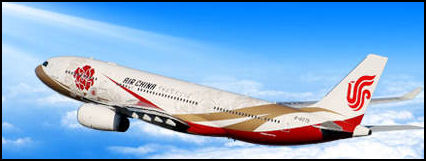
Arriving in Hong Kong is not the same as arriving in a Chinese city. You have to go through customs and immigration when you enter Hong Kong and again in China. In September 2004, China agreed to allow more flights between Hong Kong and cities on the mainland, a move that was expected to make air travel to mainland easier, less expensive and possibly safer.
Air traffic among Chinese carriers increased 15 percent in 2006 to 160 million passengers. Flights in and out of Beijing are sometimes delayed or even cancelled in the winter because of heavy fog that reduce visibility to a few dozen meters. Flights at Shanghai international airport have been suspended for several hours due “to control traffic volume.” The airports are of relatively good quality. The problem is that air traffic control is lacking and can not keep up with increase in air traffic.
Air Safety: Airsafe.com Airsafe Air Crashes Record Office baaa-acro.com/ . Aviation Safety Network aviation-safety.net ; Aviation Accidents U.S. Departmen of Transportation ntsb.gov/ntsb/query. ; Air Claims Limited is a London-based aviation consulting firm that provided information on air safety. Seating Plans for Airlines: Seat Guru Seat Guru Tracking Flights: Flight Explorer . Distances Between Cities: Indo.com Indo, com Airport CodeS : Airport City Codes
Long Flights: Do exercises in your seat, drink lots of water, avoid alcohol, and periodically get up and move around to reduce the risk of getting "economy class syndrome" (deep-vein thrombosis, DVT), which occurs when a blood clot forms in the leg and moves to the brain, lungs or heart.
AIRLINES THAT FLY TO CHINA
National Carrier: Air China Air China tel. 1-800-882-8122) is the main state-owned international carrier. As of 2002 it operated 43 international and 71 domestic routes. Air China has daily service between Beijing, Shanghai and Hong Kong in China and Tokyo, Seoul, Bangkok, and Singapore, and other destinations in Asia and Europe. Air China Offices: 45 E 49th St., New York, NY 10017, tel. (212)-371-9898; fax: (212)-935-7951: 185 Post Street, San Francisco CA 94108, tel. (415)-392-2161, fax: (415)-392-6214.
Air China announced in 2006 that it would join the Star Alliance. It has a code-sharing arrangement with Delta that allows China Air passengers to get Delta frequent flier mileage. China Southern Airlines is China’s largest airline is flies to a number of cities in Asia. China Eastern is based in Shanghai. It flies to 20 international cities in Asia, Europe and the United States.
China Eastern Airlines Fly China Eastern , and China Southern Airlines Fly China Southern ,
Hainan Airlines hnair , Shanghai Airlines Shanghai Air ) and Shenzhen Airlines Shenzhen Air also have some international flights. Air China, China Eastern, and China Southern as well as China Northwest and Xinjiang Airlines used to be part of Civil Aviation Administration of China (CAAC). CAAC had a poor safety record and mainly used Russian-built Tupolevs, Yakovlevs and Ilyushins. These days Chinese airlines mostly fly Boeing Airbus 320s and Boeing 747s, 737s and 767s. Billions of dollars worth of new planes are on order from Airbus and Boeing.
Major Cities with Connections to Beijing: As of 2006, Beijing Capital Airport was connected to 98 international air routes in 30 countries United Airlines and Air China officer nonstop service from New York, Los Angeles and San Francisco.
Major Airlines that fly to China: Airline Contact Airline Contact Several dozen international airlines fly into China, including British Airways, United Airlines, Continental, Northwest, Delta, Korean Air, Asiana, Cathay Pacific, Singapore Airlines, Thai Airways, Air France, Aeroflot, Philippines Airlines, Lufthansa, KLM, and Biman (the Bangladesh airlines), Japan Airlines, and All Nipon Airlines.
American Airlines offers direct flights between Chicago and Shanghai; Northwest has flights between China and Detroit; and United has flights between Beijing and Chicago and between Shanghai and San Francisco and has nonstop daily flights between Beijing and Washington D.C. Continental has daily service between Newark and Beijing. The 13-hour flight is on 283-seat Boeing 777-200ER. Delta is seeking a nonstop route between Atlanta and Shanghai in 2008.
The number of flights between China and the United States is increasing. A new deal was signed with China in July 2004 that has allowed U.S. carriers to increase the number of flights between the United States and China fivefold. Under the agreement U.S. carriers can fly to as many Chinese cities as they want. Before the agreement the could only fly to five American cities.
As of 2005, British Airways had 17 to 21 flights a week from Heathrow to Hong Kong, six flights a week to Beijing and was making plans to offer flights to Shanghai. Virgin Atlantic offers direct flights between Shanghai and London. Oasis Hong Kong is a new long-haul budget airlines that offers flights between Gatwick Airport in London and Hong Kong for as low as US$130 one-way before taxes and provides hot food and 14 entertainment channels on a personal video screen. It began service in October 2006 and planned to begin offering flights between Hong Kong and Oakland Airport in 2007. Founded by Stephen Miller, the founder of Dragonair, it also has permission to fly to Berlin, Cologne, Milan and Chicago.
Air Asia has cheap flights between China and Southeast Asia Hong Kong-based Dragonair has more flights to mainland China (about 400 a week) than any other airline, with service to places like Chongqing, Chengdu, Kunming, Guilin, Ningbo and Nanjing as well to Asian destinations such a Kota Kinabalu. Malysia, Phnom Penh, Cambodia and Phuket, Thailand. Dragonair is part of the One World Alliance along with Cathay Pacific. JAL Express plans to offer budget flights between China, South Korea and Japan in 2009.
AIR WEB SITES
China Air Bookings Web Sites: Fly China Fly China .
Air Bookings Web Sites: Orbitz Orbitz Dohop Dohop Mobissimo Mobissimo ; Cheap Flights Cheap Flights ; Sidestep.com Sidestep ; Qixo.com Qixo ; Kayak.com Kayak ; Yahoo Travel Yahoo Travel ; Cheapticket.com Cheap Ticket ;Skyauction Sky Auction ; Expedia Expedia ; Travelocity Travelocity .
CHEAP FLIGHTS TO CHINA
High and Low Season: Prices for plane tickets usually vary with the season. The low season is usually from early September to mid-December and from January through May with the exception of Chinese New Year in February. The high season is generally during late July, August, late December, early January and around Chinese New Year in early February. The mid season is generally in June and early July and early September. Each airline determines it own seasons but they generally follow this pattern. Prices vary between a US$50 to US$1000 for each season. For example a ticket from New York to Beijing may cost US$700 in the low season, US$900 in the mid season and US$2000 in the high season.
Cheap Flights: International flights to Hong Kong are generally significantly cheaper than those to cities in mainland China. There is a local train from Hong Kong to the Chinese border and buses and trains from the border to Guangzhou (Canton). The main holiday seasons are around Chinese New Year in early February and the May-Day-Golden Week holiday in May and the summer holiday in July and August.
It is hard to get a cheap one way plane ticket to China. They best buys are generally for round trip tickets that often include stops in other European cities. Travel Agencies that sell cheap tickets are called "consolidators" in the United States and "bucket shops" in Britain. They make money by buying blocks of tickets at a cheap price and reselling them.
Be careful dealing when dealing with consolidators and bucket shops. Their tickets are usually laden with restrictions, their travel agents are skilled at putting people off and not coming through with tickets until the last minute. The bucket shops in London are worse than their counterparts in the States. For more information see Appendix VII on Cheap Flights.
See Air Booking Web sites Above.
From New York: A one-way ticket from New York to Beijing is US$400. A round-trip ticket is US$500. Check out the ads in the New York Times Sunday Travel Section. From Los Angeles and San Francisco: A one-way ticket from Los Angeles to Beijing is US$350. A round-trip ticket is US$400. Check out the ads in Sunday Travel sections in the Los Angeles Times and the San Francisco Chronicle.
From London: A round-trip ticket from London to Beijing is about US$500. There are also many cheap package tours. Many London bucket shops advertise in the London entertainment weekly Time Out. You can also try the Sunday editions of the British newspapers like the Guardian, the Independent or The Times. From Other Cities: Check out the Sunday Travel sections in the major newspapers in the cities from which you want to fly. Also check the cheap travel agencies advertise in the Lets Go books.
Package Tours: Cheap package tours, including flight and accommodation to China are offered from major cities in Europe and the United States. Packages tours to China are not as common as package tours to other places. The tours are usually arranged by travel agencies.
AIRPORTS AND AIRPORT TRANSPORTATION IN CHINA
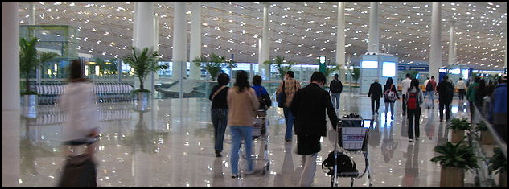
Inside new Terminal 3 at the Beijing Airport
Airport Tax: The US$10 fee on international flights has been added to airplane ticket prices.
Airports: China plans to spend US$18 billion between 2007 and 2010 expanding its airports.
Beijing Capital International Airport ( BCIA , Wikipedia , Wikipedia) is about 15 miles from the Forbidden City. The busiest airport in China and the ninth busiest airport in world, it handled 52 million passengers in 2007, up from 48.7 million passengers in 2006, and 41 million passengers in 2005. To help handle all these people a third runway opened in October 2007.
Beijing Capital International Airport is about 15 miles from the Forbidden City. With the exception of the new airport in Hong Kong, it is much larger and better-equipped than other Chinese airport. Expansion phase 1 for the airport — completed in October 1999 — added a new large H-shaped terminal next to drab old airport, notorious it poor service and the crowds that jostled for space around the check-in counters, arrival area and taxi stands.
The new Terminal 3 at Beijing airport opened in February 2008 before the 2008 Olympics. Designed by the famous architect Norman Foster, it is the world’s largest terminal and airport building, covering 10 million square feet, standing seven stories high and extending 3.9 kilometers. It required 39,000 workers to build and will accommodate 53 million passengers, increasing capacity at the airport to 78 million passengers a year. Even though its has more floor space than all five Heathrow terminals combined it has filled faster than expected due to the rapid growth of China's economy. In 2010 the airport handled 73.9 million passengers. By 2015, this is expected to rise to 90 million — 12 million more than it was designed for.
Terminal 3 cost US$3.65 billion and is bigger than all five terminals at Heathrow put together. Divided into three sections connected by a shuttle train, it has a concourse that is nearly three kilometers long, 136 aircraft stands and sections with their own security and travel document controls. There is train station for trains to downtown and a multitude of shops selling luxury goods. The terminal was built rapidly and with a minimum of fuss because the builders did not have to worry about environmentalists, financing or pubic hearings about noise and other matters that might affect the local.
Architecture critic Paul Goldberger wrote in The New Yorker, Foster “has established a pattern so clear that your natural instinct is to walk straight ahead from the front door to where you need to go. The sheer legibility of the place would be achievement enough, given its size...Even more remarkable than this organizational feat, however, is the fact that Terminal 3 is also an aesthetically exhilarating place to be.
”Its long, low shape appears to rise gradually, as if its roof touched the ground at each end...The structures sensuous curves...make you think of movement, while still appearing serene...Inside the terminal, with its high, vaulted ceiling and wall of glass facing the airfield, loosely recalling Saarinen’s TWA Terminal, but this room is big enough to contain that entire building.”
The new terminal is used mainly by Air China and its domestic and international partners but is also used by Sichuan Airlines Shandong Airlines, Qatar Airways, Qantas Airways, British Airways, Emirates, Air Canada, El Israel Airlines, Air China, Lufthansa, Singapore Airlines and members of the Star Alliance.
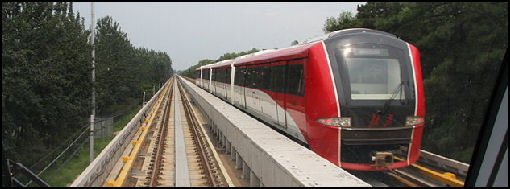
New Beijing airport train
Airport to City Transportation in Beijing BCIA : New subway lines built at a cost of US$3.3 billion that opened three weeks before the Olympics in 2008 include the new Airport Line which connects the airport with Lines 1, 10 and 13 of the Beiing subway. The trains are fast, covering 28 kilometers in 20 minutes. The railway is elevated and offers good views of Beijing.
The subways that connect with the Airport Line are: 1) The east-west line (Line 1) runs through Tiananmen Square, Wangfujing and the World Trade Center before heading to the eastern and western reaches of the city. 2) The L-shaped Line 10 passes south of the Olympic Green and follows the Third Ring Road through the Embassy District. 3) Line 13, an aboveground light rail, extends to the north of city, connecting the northern suburbs with the east-west line.
The subways operate from 5:30 am to 11:00pm. Subway tickets are two yuan (30 cents) except those for the Airport Line which are 25 yuan. Tickets are purchased with touch screens. Once you figure out how to switch the ticket machines to English everything is easy. You select the station you are going to, the number of tickets and method of payment, put in your money and out comes the tickets and change. Paper tickets were phased before the Olympics.
If you take a taxi avoid the taxi touts and wait for a regular taxi. Make sure that you take one that has a “supervision card” displayed on the front passenger dashboard and insist they use the meter. It should cost around 100 to 130 yuan (US$12 to US$15), including the 10 yuan for the airport expressway toll.
There are airport buses that leave from Gate 11 at the main terminal at Beijing international airport. The Route A bus stops at the Hilton, the Swissotel, Dongzhimen and Chaoyandmen subways stops before terminating at the International Hotel near Beijing’s central train station. The Route B bus stops at the SAS Royal Hotel, Friendship Hotel, before terminating at Changan Avenue near the Gongzhufen subway stop. Buy the tickets at the desk in the airport terminal not on the bus.
The trip from the Beijing airport to downtown can tale anywhere from 30 minutes to two hours depending n the traffic. Tour agencies and hotels often provide transfer service for their guests.
Construction of Beijing’s airport link began in August 2006. The 28.1 subway line will connect the airport with downtown Beijing and is expected to be completed n April 2008 in time for the 2008 Beijing Olympics. the journey will be 16 minutes.
Shanghai Airport ( Shanghai Airport ) : Shanghai has two airports: Pudong, the new one, and Hongqiap, the old one. The number of passengers at these airports has been increasing ay a rate of 20 percent a year. The new US$1.5 billion Shanghai Pudong International Airport is 20 miles east of Shanghai in the Pudong development zone. Opened in October 1999, it boasts a sweeping French-designed blue roof model after a pair of wings and is schedule to have five runways and be able to accommodate 80 million passengers..
Pudong airport had a capacity of 126,000 flights and 20 million passengers in the early 2000s. An expansion project was launched in December 2005, included the construction of a second terminal and a third runway. The project is schedule to be completed in 2008. By 2015, Pudong airport will have a total of three terminals, two satellite halls and five runways.
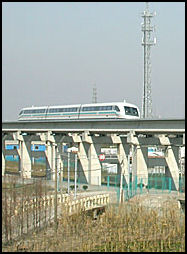
Maglev Train
Airport to City Transportation in Shanghai Shanghai Airport.com , Wikipedia Wikipedia : A good strategy in Shanghai is to take public transportation to the city center — namely the new futurist train — and then take a taxi to your hotel. Shanghai is the home of the world’s first commercial magnetic levitation (maglev) train. Opened in early 2004 and built by German engineers at a cost of US$1.2 billion, it reaches speeds of 260mph (415kph) and covers the 19 miles distance between Pudong International Airport to the 88-story Jin Mao Tower in downtown Shanghai in less than eight minutes.
The maglev is regarded a prestige project intended to boost the standing of Shanghai and China as whole, not necessarily to make money. The stations look like futuristic lace tubes. The streamlined trains, which look like crosses between space-age fighters and conventional trains, hoover millimeters above a single gray track that is several stories above the ground and imbedded with powerful magnets that produce a faint humming when the trains pull in the stations.
Passengers are told by a loudspeaker voice when they enter the train that they will be “flying without wings.” As the train accelerates there are few indication that the train is traveling extremely fast other than the buildings blurring by. You don’t even feel any vibrations until the train tops 400lph. The Chinese are so proud of the train they have even opened a little museum that explains how it works at downtown departure terminal.
The trains depart every 15 to 20 minutes from 8:30am to 5:30pm, which means it often isn’t running when many flights arrive and depart. Tickets are US$6 each way. Foreign tourist are thrilled by the ride, saying it is better than Disneyland. Business travelers and local people are less excited. They often just take a taxi from airport, saying that is more convenient than taking the maglev downtown and working out a taxi or public transportation from there to their hotels or home. They also complain about the long walk to the airport maglev terminal, the inconvenient times of operation and say the route isn’t very well marked. Prices have been slashed by a third to encourage more people to take it but still many people opt for other forms of transport. When the maglev opened it ran at 20 percent capacity. After ticket prices were lowered it ran at 27 percent capacity. A new highway linking the airport to downtown Shanghai is being built.
Guangzhou Airports: There are five major airports with 80 miles of Guangzhou: in Guangzhou, Hong Kong. Macau, Shenzhen and Zhuhai. Baiyun Airport in Guangzhou opened in August 2004. Just 80 miles away from Hong Kong, it cost US$2.4 billion and has two runways and will be able to handle 25 million passengers a year by 2010.
Airport to City Transportation in Guangzhou: The light railway that will connect Baiyin airport to Guangzhou’s Metro lines is expected to be completed in 2007. In the meantime people take taxis and buses, using the airport expressway that connects the Guangzhou -Shenzhen and Beijing-Zhubai highways.
Airport Web site: Airwise Airwise offers reviews of airports, lists the airlines that fly there and provides information on local transportation, departure taxes, car rental services and arrival and departure times.
GETTING TO CHINA OVERLAND

Karakorum Highway
The Lonely Planet Guides and Web sites are particularly good in this department and have the latest information. TRANSPORTATION BETWEEN HONG KONG AND CHINA: There are five ways to get from Hong Kong to China: 1) You can take a Hong Kong train to Lo Wu, cross the border, and catch another train in Shenzhen China; 2) You can take a train from Kowloon (Hong Kong) to Guangzhou (Canton); 3) You can take a catamaran hydrofoil from Hong Kong to Guangzhou or Wunzhu (about 5 hours by bus from Guilin). 4) you can fly; or 5) go via Macau.
You catch the catamaran hydrofoil at the old Macau ferry or Tai Kok Tsui terminal in Hong Kong and the Zhoutozui Wharf, south of Shaniam Island in Guangzhou. The journey takes about three hours. The hydrofoil from Guangzhou leaves at 8:15am and 11:15am.
Train from Hong Kong to the Chinese Border: The train that runs between Kowloon and the Chinese border makes about ten stops. It's termination points are the 1) Kowloon-Guangzhou Railway Station in Hunghom on the Kowloon side of the Harbor in Hong Kong and 2) Lo Wu station at the border of China at Shenzhen. Trains to the border run every 10 minutes. From Hunghom station the trip covers 34 kilometers and takes about 40 minutes. Tickets cost about US$4 for a normal seat and US$10 for a first class seat.
Crossing the border generally takes about 30 minutes but can take longer. The Lo Wu border crossing between Shenzhen and Hong Kong is one of the busiest in the world. About 400,000 people cross every day. The border is open from 6:30am to 12:00midnight. There has been a suggestion of opening the border for 24 hours a day.
Trains between Hong Kong and Canton: Once in Shenzhen you can take direct trains to Beijing, Shanghai and Guangzhou. Fast trains between Shenzhen and Guangzhou run every hour The trip take about an hour. You can also take a minibus and a bus to Guangzhou. The trip takes about three hours. There are two daily trains from Shenzhen to Beijing. Train ticket can be purchased at China International Travel Service (CITS) in Hong Kong. See tourist offices for the phone number and address.
Train Between Hong Kong, Beijing and Xian: There is new service between Hong Kong and Beijing, which covers 1,410 miles in 29 hours. An adult deluxe berth ticket costs around US$150 and second class berth US$120. Prices are much cheaper for Chinese. There is also a direct train between Hong Kong and Xian.
Vietnam: Travelers can enter China from Vietnam on the train between Hanoi and Kunming. The train runs twice a week between Beijing and Hanoi. Laos and Thailand: It is possible to enter China from Thailand and Laos on the Mekong River and the newly upgraded road between Laos and China (See Laos). Myanmar: There is a busy border crossing between Ruuli (Yunnan Province of China) and Muse (Myanmar) used mainly Chinese going to Myanmar to gamble.
Nepal: The main crossing point between Tibet and Nepal is the Nepalese town of Kodari. It is difficult to get permission to enter China from Nepal and most people that do it are members of organized tours. The border may be open: contact the Chinese Embassy for the latest information and details.
Pakistan: It is possible to travel overland between western China and northern Pakistan over Khunjerab Pass on the Karakoram Highway. There are some buses that travel the entire route. Many travelers take a Pakistani bus from Islamabad to the border and change to Chinese bus on the Chinese side of the border and travel to the Silk Road town of Kashgar (China). A lot travelers follow this route. India: The border is mostly closed.
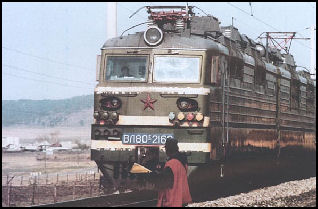
Trans-Siberian train
Trans-Siberian Railroad: There are two routes through China that hook up with the Trans-Siberian Railroad. Both start or finish in Beijing. One route passes through Mongolia and takes about six days to reach Moscow. The other route passes through northeast China and takes about a 1½ days longer. It is generally cheaper to go from Beijing to Moscow than visa versa. Generally it is cheaper to make arrangements for your ticket outside of China or Russia. See Russia.
Central Asia: See Kazakstan, Kyrgyzstan and Tajikistan. London: It is now possible to travel by train all the way from Ho Chi Minh City and London on eight separate trains.
GETTING TO CHINA BY FERRY
Ferry Information typepad.com From Korea: Visit Korea Visit Korea There is a 17-hour, twice-a-week ferry between Inchon, South Korea and Weihai, China. It costs US$90-US$225. There is also a 28-hour, twice-a-week ferry between Inchon and Tianjin, China. It costs US$115-US$350. From Japan: See Japan See Japan China-Japan ferries include: 1) Shimonoseki, Japan and Qingdao, China; 2) one between Shanghai and Osaka (US$230-US$570 one-way); 3) and one between Tianjin, China and Kobe, Japan (US$290-US$1500). There is also a ferry between Kaohsiung, Taiwan and Naha, Japan (US$150-US$250 one-way).
CRUISE SHIPS that already stop or are considering stopping in China include Royal Cruise, Holland America, Royal Viking, Orient Lines, Seven Seas Cruise Line. The Shanghai international Cruise Terminal opened officially in the summer of 2008.
Image Sources: 1) CNTO (China National Tourist Organization; 2) Perrochon photo site; 3) official air line and airport wesites; 4) Seat 61 train site; 5) Maglev, Gluckman.com; 6) Wikipedia
Text Sources: CNTO, New York Times, Washington Post, Los Angeles Times, Times of London, National Geographic, The New Yorker, Time, Newsweek, Reuters, AP, Lonely Planet Guides, Compton’s Encyclopedia and various books and other publications.
